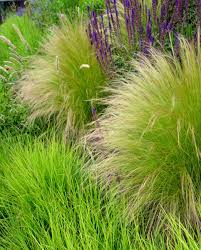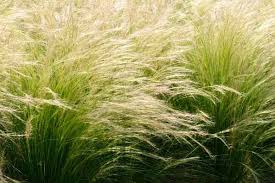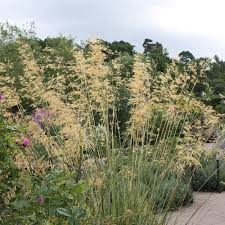Stipa Grass, scientifically known as Stipa, is a fascinating and pleasing grass that graces landscapes across various regions of the world. Its scientific name, Stipa, comes from the Latin word for “stalk” or “stem,” emphasizing the prominence of its long, slender leaves and graceful flowering stems.
With its distinctive appearance and ecological significance, Stipa grass holds a special place in both natural ecosystems and cultivated gardens.
Found in a diverse range of environments, from arid deserts to more temperate zones, Stipa grass demonstrates an impressive ability to adapt and thrive. Its adaptability is attributed to the vast number of species within the Stipa genus, each with its own unique characteristics and preferences. This adaptability makes Stipa grass a versatile choice for landscape designers, gardeners, and conservationists.
The hallmark of Stipa grass’s appearance is its feathery inflorescence. Delicate, airy flower spikes emerge from the grass, creating an enchanting visual effect as they sway gently in the wind. This unique feature has earned Stipa grass common names like “feather grass” or “needle grass.” The fine texture and graceful movement of the plumes make Stipa grass an excellent candidate for adding texture and motion to outdoor spaces.
Gardeners and landscapers often incorporate Stipa grass into their designs to introduce an element of elegance and movement. Whether used as a focal point in a garden bed, a border along pathways, or even in larger landscape plantings, Stipa grass’s striking appearance adds a touch of drama and sophistication. Its ability to catch and scatter light lends a dreamlike quality to landscapes, creating an ever-changing scene throughout the day.
Beyond its ornamental value, Stipa grass plays a crucial role in the ecosystem. In its natural habitats, such as grasslands and prairies, Stipa grass contributes to soil conservation. Its extensive root system helps bind soil particles, preventing erosion and enhancing soil stability. Additionally, the grass provides habitat and sustenance for a variety of insects and animals, contributing to overall biodiversity.
Cultivating Stipa grass can be a rewarding endeavor for gardening enthusiasts. To successfully grow Stipa grass, choose a sunny location with well-draining soil. Depending on the species, you can opt for seeds or established plants. Ensure proper watering until the grass becomes established, after which it usually requires minimal maintenance.
In addition, Stipa grass (Stipa) is a captivating and versatile plant that enchants with its feathery appearance and gentle sway. Its adaptability, coupled with its ecological significance, makes it a noteworthy addition to landscapes both natural and cultivated. Whether enhancing gardens with its elegance or contributing to ecosystem health, Stipa grass stands as a testament to the beauty and resilience of the plant kingdom.
Read Also: How to Plant Fruit Trees for Optimum Performance
Growing and Care Guide of Stipa Grass

Stipa Grass, also known as feather grass or needle grass, is a beautiful and adaptable plant that can add charm to your garden or landscape. Here’s a comprehensive guide on how to grow and care for Stipa grass:
1. Choosing the Right Location: Select a sunny spot for planting Stipa grass. It thrives in full sunlight and well-draining soil. Ensure that the chosen area receives at least 6 hours of direct sunlight daily.
2. Soil Preparation: Stipa grass prefers soil with good drainage. If your soil is heavy or clay-like, consider amending it with sand or organic matter to improve drainage.
3. Planting: You can plant Stipa grass from seeds or as established plants. If using seeds, sow them in the prepared soil in early spring or fall. Cover the seeds lightly with soil and keep the area consistently moist until they germinate.
4. Watering: During the establishment phase, water the newly planted Stipa grass regularly to keep the soil consistently moist. Once the grass is established, it is relatively drought-tolerant and requires less frequent watering. Water deeply but infrequently to encourage deep root growth.
5. Pruning and Maintenance: Stipa grass is relatively low-maintenance. In late winter or early spring, before new growth emerges, you can cut back the previous year’s growth to about 6-8 inches above the ground. This allows the new growth to emerge cleanly.
6. Fertilizing: Stipa grass generally doesn’t require heavy fertilization. A light application of a balanced fertilizer in spring can help promote healthy growth. Avoid over-fertilizing, as this can lead to excessive growth that may cause the grass to flop over.
7. Pests and Diseases: Stipa grass is relatively resistant to pests and diseases. However, keeping the area around the grass clean and free of debris can help prevent potential issues.
8. Dividing and Transplanting: Stipa grass can be divided every few years to rejuvenate its growth and prevent overcrowding. Spring or fall is the best time for dividing. Dig up the clump, separate the sections, and replant them in prepared soil.
9. Winter Care: Stipa grass is hardy in many climates, but some species may benefit from a layer of mulch around the base in colder regions. This helps protect the roots from extreme temperatures.
10. Landscaping Uses: Stipa grass can be used in a variety of landscaping settings. It works well as an accent plant, in mass plantings, or along borders. Its feathery plumes add movement and texture to the landscape.
Remember that Stipa grass is a versatile plant, with different species suited to various climates. Be sure to choose a species that is well-suited to your specific growing conditions.
By following these guidelines, you can successfully grow and care for Stipa grass, enjoying its unique beauty and graceful movement in your outdoor space.
Stipa Tenuissima

Stipa Tenuissima is a pretty plant often called Mexican Feather Grass. It looks delicate and adds a soft touch to gardens. This grass has thin leaves that move gently in the wind. In spring, it grows small flower heads that look like feathers. People like it because it looks like it’s dancing in the breeze.
Stipa Tenuissima comes from Mexico and the southwest United States. It’s special because it doesn’t need a lot of water. This is important because water is precious, and this grass helps save it.
You can use Stipa Tenuissima in many ways in your garden. It can be a border, an accent, or even a big group of plants. It makes your garden look natural and beautiful.
Taking care of Stipa Tenuissima is easy. Put it in a sunny spot where it gets a lot of sunlight. The soil should be good at draining water so the roots don’t get too wet. After it grows for a while, you only need to water it a little bit. Cut back the old parts in spring to let new ones grow.
Stipa Tenuissima doesn’t get sick easily. It doesn’t need much from you, just some sunlight and a little water. It’s a simple and lovely plant that adds a touch of nature’s beauty to your garden.
Read Also: 4 Ways of Caring for a Fruit Tree for High Production
Stipa Gigantea Grass

Stipa Gigantea, also known as Giant Feather Grass, is an impressive plant that stands tall and graceful in gardens and landscapes. This ornamental grass is admired for its grand appearance and its ability to bring a sense of drama to outdoor spaces.
Standing proudly, Stipa Gigantea is a tall grass that reaches heights of up to 6 feet or more. Its name “Giant Feather Grass” comes from its towering growth and its feathery flower heads that resemble plumes. These flower heads sway gracefully in the wind, creating a mesmerizing movement that adds life to the garden.
Stipa Gigantea is native to southern Europe and is well-suited to sunny locations with well-draining soil. Its long, arching leaves and majestic height make it a standout plant in borders, meadows, and even as a standalone specimen. In early summer, tall stems rise from the base, bearing large flower heads that turn golden as they mature. These flower heads remain attractive even after they’ve finished blooming, adding interest to the garden throughout the season.
Gardening enthusiasts often appreciate Stipa Gigantea for its architectural qualities. The tall stems and feathery plumes can create a stunning backdrop for other plants, enhancing the overall design of the landscape. When planted in groups, Stipa Gigantea can form a striking focal point that captures attention and adds a sense of movement to the garden.
Caring for Stipa Gigantea involves providing it with the right conditions to thrive. Plant it in well-draining soil and a location that receives ample sunlight. Once established, this grass is relatively low-maintenance. Regular watering during its first year of growth helps it establish strong roots. Afterward, Stipa Gigantea is known for its drought tolerance and ability to withstand dry conditions.
To maintain its tidy appearance and promote healthy growth, consider trimming back the previous year’s growth in late winter or early spring, just before new growth emerges. This will help the plant maintain its upright form and prevent it from flopping over.
In conclusion, Stipa Gigantea, or Giant Feather Grass, is a tall and striking ornamental grass that commands attention with its grandeur and movement. Its towering height, feathery flower heads, and architectural qualities make it a favorite among gardeners looking to add drama and elegance to their outdoor spaces. With its low-maintenance nature and impressive visual impact, Stipa Gigantea is a true testament to the beauty and diversity of ornamental grasses.
